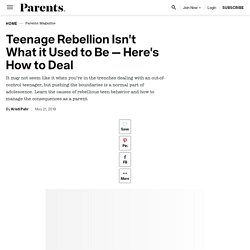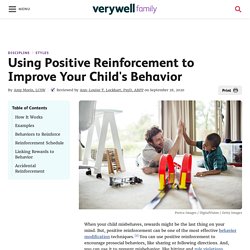

4 Types of Parenting Styles and Their Effects on Kids. Your parenting style can affect everything from how much your child weighs to how she feels about herself. It's important to ensure your parenting style is supporting healthy growth and development because the way you interact with your child and how you discipline her will influence her for the rest of her life. Researchers have identified four types of parenting styles:1 AuthoritarianAuthoritativePermissiveUninvolved Each style takes a different approach to raising children and can be identified by a number of different characteristics.
Authoritarian Parenting. Why Teenage Brains Are So Hard to Understand. Common Behaviors You'll See During Each Teen Year. Understanding adolescence, acting out, and calls for help. Teenage Rebellion Isn't What it Used to Be — Here's How to Deal. It may not seem like it when you’re in the trenches dealing with an out-of-control teenager, but pushing the boundaries is a normal part of adolescence.

Learn the causes of rebellious teen behavior and how to manage the consequences as a parent. By Kristi Pahr May 21, 2019 Once you're past the toddler stage, many parents think the worst is over. The tantrums, rule-breaking, and boundary-pushing are history and you are finally able to communicate with your child and know you're understood. Kids Health Information : Challenging behaviour – teenagers. As they develop, teenagers will experience a range of emotions and express themselves in many different ways.

It’s normal for teenagers to be moody and to show some disrespect and defiance as they go through hormonal changes and a period of brain development during puberty. Teenagers may also be short-tempered as they naturally begin to seek privacy and independence. 18 Areas Of Normal Adolescent Behavior. By: Ashley Brown Updated January 15, 2021 Medically Reviewed By: Melinda Santa Raising children is not easy, and it often gets more difficult when they reach adolescence.

Teen moods: ups & downs of adolescence. Teen moods: what you need to know Some days your child might be cheerful and excited, and other times he might seem down, flat, low or sad.

This is a normal part of life for young people in the same way it’s normal for adults. A Parent's Guide to Surviving the Teen Years. You've lived through 2 a.m. feedings, toddler temper tantrums, and the back-to-school blues.

So why is the word "teenager" causing you so much worry? When you consider that the teen years are a period of intense growth, not only physically but emotionally and intellectually, it's understandable that it's a time of confusion and upheaval for many families. Adolescent Development - The Promise of Adolescence - NCBI Bookshelf. How Negative Punishment Works. Negative punishment is an important concept in B.

F. Skinner's theory of operant conditioning. In behavioral psychology, the goal of punishment is to decrease unwanted behavior. What is Negative Punishment (Examples and Effectiveness) In this article, we will review negative punishment, its definition, examples, and drawbacks.

American psychologist B.F. Skinner developed the theory of operant conditioning, which stated that a person or animal’s behavior could be increased or decreased by adding or removing appropriate stimuli after the behavior is exhibited. Using Positive Reinforcement to Improve Behavior. When your child misbehaves, rewards might be the last thing on your mind.

But, positive reinforcement can be one of the most effective behavior modification techniques.1 You can use positive reinforcement to encourage prosocial behaviors, like sharing or following directions. And, you can use it to prevent misbehavior, like hitting and rule violations. Positive reinforcement can also be an effective way to encourage and motivate your child to be responsible, do their chores, get along with their siblings, or complete their homework assignments without arguing. Reinforcement vs. Punishment: What They Are & 12 Examples. "Reinforcement is anything that increases the likelihood that a person will exhibit the same behavior again in the future," says licensed psychologist Nicole Beurkens, Ph.D., CNS.

"You are aiming to increase a desired behavior such as speaking politely, doing chores, playing nicely with siblings, and so on. " And chances are you're likely doing this already in some capacity: You praise your kid for tidying up after themselves, you compliment them after getting good grades in school, you take them out for a treat after hitting a milestone or doing well in an extracurricular. As Pressman tells us, it's simply "giving kids attention for a certain behavior. " Positive Punishment: What It Is, Benefits, and Examples. Positive punishment is a form of behavior modification.

In this case, the word “positive” doesn’t refer to something pleasant. Positive punishment is adding something to the mix that will result in an unpleasant consequence. The goal is to decrease the likelihood that the unwanted behavior will happen again in the future. This approach may be effective in certain circumstance, but it’s only one part of the equation. Guiding your child toward alternative behaviors that are more appropriate to the situation are also needed. 12 Examples of Positive Punishment & Negative Reinforcement. You might be thinking that “positive punishment” sounds like an oxymoron, after all, how can punishment be positive? Not many people “like” punishment, right? The disconnect in understanding this concept comes from the usage of the word “positive;” here at PositivePsychology.com, we generally use the term “positive” to refer to things that are inherently good, things that are life-giving, and things that promote thriving and flourishing.
The concept of positive punishment comes from a very different era and a very different perspective on psychology; namely, the 1930s and behaviorism. Negative Reinforcement: What Is It and How Does It Work? What is negative reinforcement? Negative reinforcement is a method that can be used to help teach specific behaviors. With negative reinforcement, something uncomfortable or otherwise unpleasant is taken away in response to a stimulus. Over time, the target behavior should increase with the expectation that the unpleasant thing will be taken away.
Read on to learn more about this type of learning. The relationship between behavior and consequences is part of a type of learning called operant conditioning. Tips for Communicating With Your Teen. The teenage years have a lot in common with the terrible twos. During both stages our kids are doing exciting new things, but they’re also pushing boundaries (and buttons) and throwing tantrums. The major developmental task facing both age groups is also the same: kids must pull away from parents and begin to assert their own independence. No wonder they sometimes act as if they think they’re the center of the universe.
Teenager behaviour: 6 tips for dealing with moods, pushing boundaries and phone obsession. Parents of teenagers will know how challenging it can be living with children of this age, as they go through puberty and become young adults. All those hormones, school exams and the natural desire for more independence can make home life tricky to navigate. Now with the added restraints of the COVID-19 pandemic, both teens and parents are facing a tough time. Dealing with Disrespectful Teenage Behaviour. Discipline strategies for teenagers.
Discipline for Teens: Strategies and Challenges. New perspectives on adolescent motivated behavior: Attention and conditioning. Difference Between Reinforcement and Punishment (with Examples and Comparison Chart) - Key Differences. Reinforcement vs. Punishment: Changing Behavior. The value of reinforcing positive behaviour for our teens.
Rewarding behavior is key to parenting teens, study suggests. Parenting Teens: When It Comes To Learning, Positive Reinforcement Trumps Punishment.